Effects of age on measures of complex working memory span in the beagle dog (Canis familiaris) using two versions of a spatial list learning paradigm
- PMID: 12663753
- PMCID: PMC196663
- DOI: 10.1101/lm.56503
Effects of age on measures of complex working memory span in the beagle dog (Canis familiaris) using two versions of a spatial list learning paradigm
Abstract
The present study used two versions of a spatial list learning (SLL) paradigm to examine the effects of increased cognitive load on visuospatial working memory processes in young and old beagle dogs. In the first experiment, young, and a select group of old dogs were first presented with one item, then two, and then three, and were rewarded for responding to the novel position. The dogs were able to learn the task at short delays, but compared with young dogs, old dogs performed worse at delays of 10 sec, and could not reach longer delays. Analysis of errors indicated that memory was best for end items in the spatial list and that within sessions, the number of errors in later trials was greater than the number of errors in earlier trials. A second version of the task, a modified SLL (mSLL) was developed to control for the use of non-mnemonic strategies on the SLL task. In this version, the first two items were presented individually. Acquisition and maximal memory performance were better in the young relative to the old dogs. Similar to the original SLL design, memory for early list items was worse than memory for later list items in both young and old dogs. The within-session pattern of errors however, did not change from trial to trial on the mSLL. The present results suggest that multiple working memory processes are engaged during complex tests of visuospatial function and the neuroanatomical substrates controlling these processes are affected differentially by age in the beagle dog.
Figures
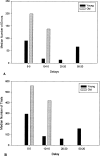
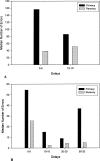


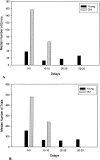
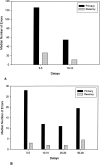

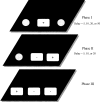
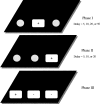
Similar articles
-
Visuospatial impairments in aged canines (Canis familiaris): the role of cognitive-behavioral flexibility.Behav Neurosci. 2002 Jun;116(3):443-54. Behav Neurosci. 2002. PMID: 12049325
-
Effect of feeding patterns on performance of a visuospatial memory task in the beagle dog: a novel cognitive-based protocol for assessing satiety.Prog Neuropsychopharmacol Biol Psychiatry. 2005 Mar;29(3):481-8. doi: 10.1016/j.pnpbp.2004.12.013. Prog Neuropsychopharmacol Biol Psychiatry. 2005. PMID: 15795057
-
Visuospatial function in the beagle dog: an early marker of cognitive decline in a model of human aging and dementia.Neurobiol Learn Mem. 2006 Sep;86(2):197-204. doi: 10.1016/j.nlm.2006.02.005. Epub 2006 Apr 17. Neurobiol Learn Mem. 2006. PMID: 16616528
-
Landmark discrimination learning in the dog: effects of age, an antioxidant fortified food, and cognitive strategy.Neurosci Biobehav Rev. 2002 Oct;26(6):679-95. doi: 10.1016/s0149-7634(02)00039-8. Neurosci Biobehav Rev. 2002. PMID: 12479842 Review.
-
Spatial learning in the 5-HT1B receptor knockout mouse: selective facilitation/impairment depending on the cognitive demand.Learn Mem. 2003 Nov-Dec;10(6):466-77. doi: 10.1101/lm.60203. Learn Mem. 2003. PMID: 14657258 Review.
Cited by
-
Dissociating the effects of delay and interference on dog (Canis familiaris) working memory.Anim Cogn. 2021 Nov;24(6):1259-1265. doi: 10.1007/s10071-021-01509-0. Epub 2021 May 5. Anim Cogn. 2021. PMID: 33950310
-
Frontal lobe volume, function, and beta-amyloid pathology in a canine model of aging.J Neurosci. 2004 Sep 22;24(38):8205-13. doi: 10.1523/JNEUROSCI.1339-04.2004. J Neurosci. 2004. PMID: 15385603 Free PMC article.
-
Behavioural and cognitive changes in aged pet dogs: No effects of an enriched diet and lifelong training.PLoS One. 2020 Sep 16;15(9):e0238517. doi: 10.1371/journal.pone.0238517. eCollection 2020. PLoS One. 2020. PMID: 32936808 Free PMC article.
-
Assessment of nutritional interventions for modification of age-associated cognitive decline using a canine model of human aging.Age (Dordr). 2005 Mar;27(1):27-37. doi: 10.1007/s11357-005-4001-z. Epub 2005 May 2. Age (Dordr). 2005. PMID: 23598601 Free PMC article.
-
Effects of a Nutritional Supplement on Cognitive Function in Aged Dogs and on Synaptic Function of Primary Cultured Neurons.Animals (Basel). 2019 Jun 27;9(7):393. doi: 10.3390/ani9070393. Animals (Basel). 2019. PMID: 31252640 Free PMC article.
References
-
- Adams B, Chan A, Callahan H, Milgram NW. The canine as a model of human cognitive aging: Recent developments. Prog Neuropsychopharmacol Biol Psychiatry. 2000a;24:675–692. - PubMed
-
- Adams B, Chan A, Callahan H, Siwak C, Tapp D, Ikeda-Douglas C, Atkinson P, Head E, Cotman CW, Milgram NW. Use of a delayed non-matching to position task to model age-dependent cognitive decline in the dog. Behav Brain Res. 2000b;108:47–56. - PubMed
-
- Babcock RL, Salthouse TA. Effects of increased processing demands on age differences in working memory. Psychol Aging. 1990;5:412–428. - PubMed
-
- Baddeley AD. Working memory. Oxford, UK: Clarendon Press; 1986.
-
- ————— . Levels of working memory. In: Naveh-Benjamin M, Moscovitch M, Roediger III HL, editors. Perspectives on human and cognitive aging: Essays in honour of Fergus Craik. New York, NY: Psychology Press; 2001. pp. 111–123.
MeSH terms
LinkOut - more resources
Full Text Sources
Other Literature Sources
Medical
